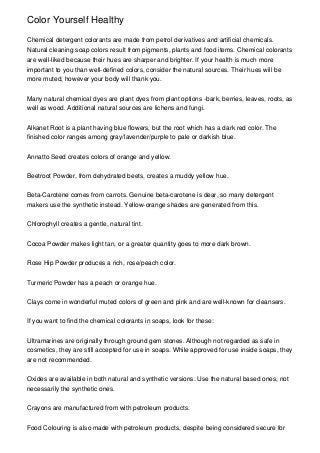
Color Yourself Healthy
- 1. Color Yourself Healthy Chemical detergent colorants are made from petrol derivatives and artificial chemicals. Natural cleaning soap colors result from pigments, plants and food items. Chemical colorants are well-liked because their hues are sharper and brighter. If your health is much more important to you than well-defined colors, consider the natural sources. Their hues will be more muted, however your body will thank you. Many natural chemical dyes are plant dyes from plant options -bark, berries, leaves, roots, as well as wood. Additional natural sources are lichens and fungi. Alkanet Root is a plant having blue flowers, but the root which has a dark red color. The finished color ranges among gray/lavender/purple to pale or darkish blue. Annatto Seed creates colors of orange and yellow. Beetroot Powder, from dehydrated beets, creates a muddy yellow hue. Beta-Carotene comes from carrots. Genuine beta-carotene is dear, so many detergent makers use the synthetic instead. Yellow-orange shades are generated from this. Chlorophyll creates a gentle, natural tint. Cocoa Powder makes light tan, or a greater quantity goes to more dark brown. Rose Hip Powder produces a rich, rose/peach color. Turmeric Powder has a peach or orange hue. Clays come in wonderful muted colors of green and pink and are well-known for cleansers. If you want to find the chemical colorants in soaps, look for these: Ultramarines are originally through ground gem stones. Although not regarded as safe in cosmetics, they are still accepted for use in soaps. While approved for use inside soaps, they are not recommended. Oxides are available in both natural and synthetic versions. Use the natural based ones, not necessarily the synthetic ones. Crayons are manufactured from with petroleum products. Food Colouring is also made with petroleum products, despite being considered secure for
- 2. consumption. Food Grade Colorant is often found in soap making, but this is also made from petrol products. The scent associated with soap is a tricky area. You need to understand the particular terms employed, as they can cause confusion in between natural soap and synthetic detergent. Essential Oil organic soap is really a natural scented soap. Essential oil, extracted from plants, is used here. Fragrance Oil detergent, on the other hand, just isn't natural cleaning soap. Fragrance oils are created synthetically in the laboratory to imitate a scent, usually for one that's impossible to collect or too expensive to collect naturally. One of the most well-known and healthy ingredients inside natural soap is Olive oil. It is a refined oil base obtained from Italian grown olives. The oil is expelled at 70 degrees, then is filtered and highly processed to a light color and odor ideal for use in many different cosmetics, soap making applications and toiletries. It adds moisturizing features to creams, lotions and also bar soap. Among the natural anti-oxidants to be found in olive oil, there are A as well as E vitamins, as well as some polyphenols, effective towards aging. Lynden House International is well known for its high quality products, which range from soap making supplies, essential oils, fragrance oils, carrier oils, cream bases, emulsifiers and waxes to gel, colorants and aromatherapy materials. cream bases